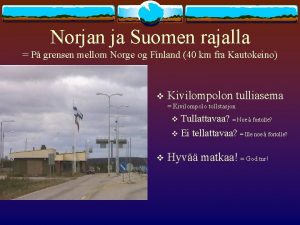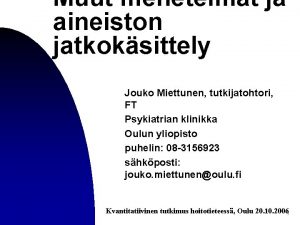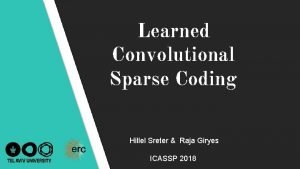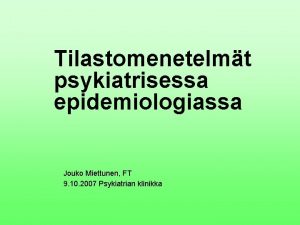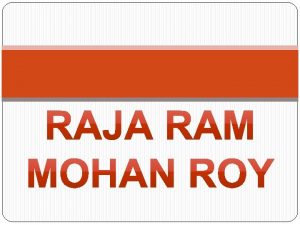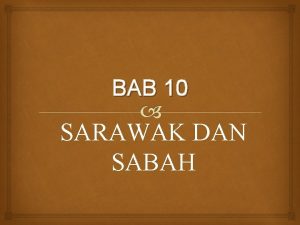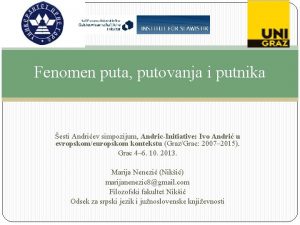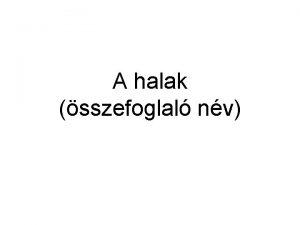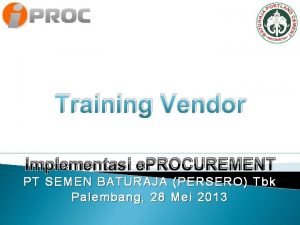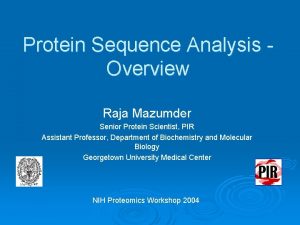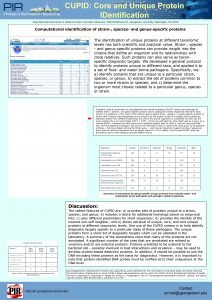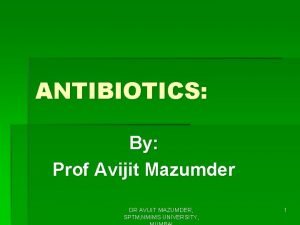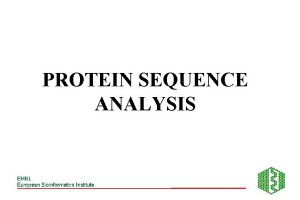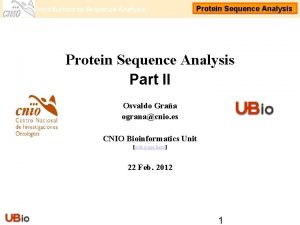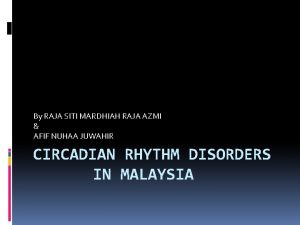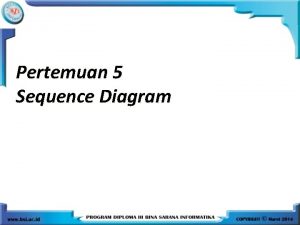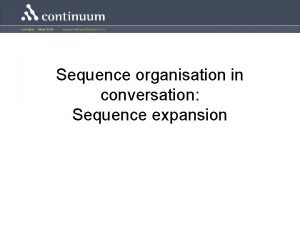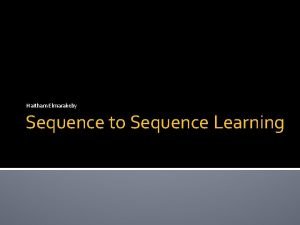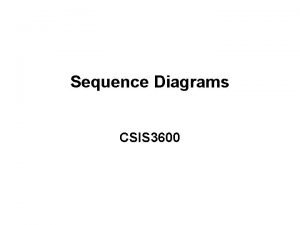Protein Sequence Analysis Overview Raja Mazumder Scientific Coordinator



































- Slides: 35

Protein Sequence Analysis Overview Raja Mazumder Scientific Coordinator, PIR Research Assistant Professor, Department of Biochemistry and Molecular Biology Georgetown University Medical Center NIH Proteomics Workshop 2006

Overview Ø Proteomics and protein bioinformatics (protein sequence analysis) Ø Why do protein sequence analysis? Ø Searching sequence databases Ø Post-processing search results Ø Detecting remote homologs 2

Clinical Proteomics From Petricoin et al. , Nature Reviews Drug Discovery (2002) 1, 683 -695 3

Single protein and shotgun analysis Mixture of proteins Shotgun analysis Gel based seperation Single protein analysis Digestion of protein mixture Spot excision and digestion Peptides from many proteins Peptides from a single protein LC or LC/LC separation MS analysis MS/MS analysis Protein Bioinformatics 4 Adapted from: Mc. Donald et al. 2002. Disease Markers 18 99 -105

Protein Bioinformatics: Protein sequence analysis Helps characterize protein sequences in silico and allows prediction of protein structure and function Ø Statistically significant BLAST hits usually signifies sequence homology Ø Homologous sequences may or may not have the same function but would always (very few exceptions) have the same structural fold Ø Protein sequence analysis allows protein classification Ø 5

Development of protein sequence databases Atlas of protein sequence and structure – Dayhoff (1966) first sequence database (prebioinformatics). Currently known as Protein Information Resource (PIR) Ø Protein data bank (PDB) – structural database (1972) remains most widely used database of structures Ø Uni. Prot – The United Protein Databases (Uni. Prot, 2003) is a central database of protein sequence and function created by joining the forces of the SWISS-PROT, Tr. EMBL and PIR protein database activities Ø 6

Comparative protein sequence analysis and evolution Patterns of conservation in sequences allows us to determine which residues are under selective constraints (are important for protein function) Ø Comparative analysis of proteins more sensitive than comparing DNA Ø Homologous proteins have a common ancestor Ø Different proteins evolve at different rates Ø Protein classification systems based on evolution: PIRSF and COG Ø 7

PIRSF and large-scale functional annotation of proteins Ø PIRSF structure is in the form of a network classification system based on the evolutionary relationships of whole proteins and domains Ø As part of the Uni. Prot project, PIR has developed this classification strategy to assist in the propagation and standardization of protein annotation 8

Comparing proteins Ø Amino acid sequence of protein generated from proteomics experiment l e. g. protein fragment DTIKDLLPNVCAFPMEKGPCQTYMTRWFFNFETGECELFAYGGCGGNSNNFLRKEKCEKF CKFT Ø Amino-acids of two sequences can be aligned and we can easily count the number of identical residues (or use an index of similarity) to find the % similarity. Ø Proteins structures can be compared by superimposition 9

Protein sequence alignment Ø Pairwise alignment l l abacd ab_cd Ø Multiple sequence alignment usually provides more information l l l abacd ab_cd xbace Ø Multiple alignment difficult to do for distantly related proteins 10

Protein sequence analysis overview Ø Protein databases l PIR and Uni. Prot Ø Searching databases l Peptide search, BLAST search, Text search Ø Information retrieval and analysis l l Protein records at Uni. Prot and PIR Multiple sequence alignment Secondary structure prediction Homology modeling 11

Universal Protein Knowledgebase (Uni. Prot) PIR (Protein Information Resource) + EBI (European Bioinformatics Institute) + SIB (Swiss Institute of Bioinformatics) maintain Uni. Prot http: //www. uniprot. org/ Uni. Prot NREF Automated Annotation Literature-Based Annotation Uni. Prot Knowledgebase Automated merging of sequences Swiss. Prot Clustering at 100, 90, 50% Uni. Prot Archive Tr. EMBL PIR-PSD Ref. Seq Gen. Bank/ Ens. EMBL/DDBJ PDB Patent Data Other Data 12

Peptide Search 13

ID mapping 14

Query Sequence Ø Unknown sequence is Q 9 I 7 I 7 Ø BLAST Q 9 I 7 I 7 against the Uni. Prot knowledgebase (http: //www. pir. uniprot. org/search/blast. shtml) Ø Analyze results 15

BLAST results 16

Text Search 17

Text search results: display options Moving Pubmed ID and PDB ID into “Columns in Display” 18

Text search results: add input box 19

Text Search Result with NULL/NOT NULL 20

Uni. Prot protein record: 21

SIR 2_HUMAN protein record 22

Are Q 9 I 7 I 7 and SIR 2_HUMAN homologs? Ø Check BLAST results Ø Check pairwise alignment 23

Protein structure prediction Programs can predict secondary structure information with 70% accuracy Ø Homology modeling prediction of ‘target structure from closely related ‘template’ structure Ø 24

Secondary structure prediction http: //bioinf. cs. ucl. ac. uk/psipred/ 25

Secondary structure prediction results 26

Sir 2 structure 27

Homology modeling http: //www. expasy. org/swissmod/SWISS-MODEL. html 28

Homology model of Q 9 I 7 I 7 Blue - excellent Green - so so Red - not good Yellow - beta sheet Red - alpha helix Grey - loop 29

Sequence features: SIR 2_HUMAN 30

Multiple sequence alignment 31

Multiple sequence alignment Ø Q 9 I 7 I 7, Q 82 QG 9, SIR 2_HUMAN 32

Sequence features: CRAA_RABIT 33

Identifying remote homologs 34

Structure guided sequence alignment 35
 Raja mazumder
Raja mazumder King hindi song
King hindi song Carrier vs channel proteins
Carrier vs channel proteins Protein-protein docking
Protein-protein docking Information gathered during an experiment
Information gathered during an experiment How is a scientific law different from a scientific theory?
How is a scientific law different from a scientific theory? Nucleotide sequence vs amino acid sequence
Nucleotide sequence vs amino acid sequence Pseudocode selection
Pseudocode selection Difference between infinite and finite sequence
Difference between infinite and finite sequence Convolutional sequence to sequence learning.
Convolutional sequence to sequence learning. Anak prabu siliwangi
Anak prabu siliwangi Raja hutan menjadi tuan rumah konferensi para binatang
Raja hutan menjadi tuan rumah konferensi para binatang David trone internship
David trone internship Rantakokko enontekiö
Rantakokko enontekiö Toistettujen mittausten varianssianalyysi
Toistettujen mittausten varianssianalyysi Raja giryes
Raja giryes Torpedo mramorove
Torpedo mramorove Raja marie antoinette
Raja marie antoinette Reabiliteetti
Reabiliteetti Salah satu warisan peradaban
Salah satu warisan peradaban Rrrlf in library science
Rrrlf in library science Raja ram mohan roy grave
Raja ram mohan roy grave Raja hasan saregamapa 2007
Raja hasan saregamapa 2007 Sinopsis lang buana
Sinopsis lang buana Dr raja rizwan
Dr raja rizwan Hubungan sarawak dan sabah dalam alam melayu tingkatan 2
Hubungan sarawak dan sabah dalam alam melayu tingkatan 2 Dr raja rizwan
Dr raja rizwan Hason raja family tree
Hason raja family tree Glockenfaçon
Glockenfaçon Travnicka raja
Travnicka raja Deomai artinya
Deomai artinya Raj rani vs prem adib case summary
Raj rani vs prem adib case summary Maradványhal
Maradványhal Why did hason raja leave the life of comfort and pleasure
Why did hason raja leave the life of comfort and pleasure Eproc semen baturaja
Eproc semen baturaja The word yoga
The word yoga













